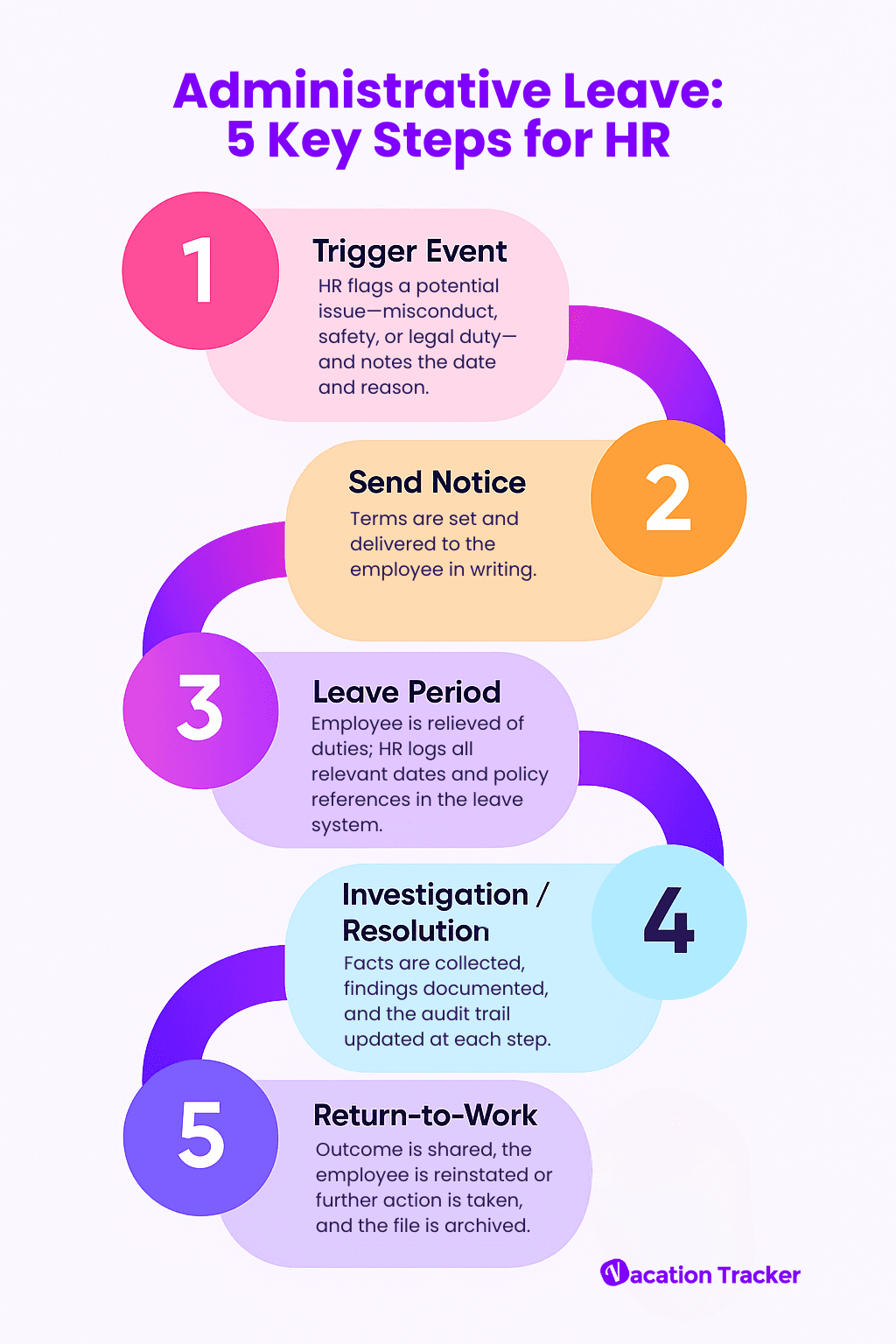Last updated on July 18, 2025
So, you’ve outlined clear policies for Sick Days, Vacation, and Maternity or Paternity Leave in your employee handbook, but what about administrative leave? While it might be less common, Human Resources (HR) Departments need to be ready with clear policies and procedures to avoid headaches.
Not sure where to start? Let us help. 🙋
In this guide, we’ll tell you everything HRs need to know about administrative leave, from how to implement it to best practices for managing it.
What is Administrative Leave?
Administrative leave is the temporary suspension of an employee from their role that can be either paid or unpaid, depending on the circumstances. It is usually imposed by the employer in specific situations like internal investigations, personal emergencies, or even military service.
Administrative leave with pay is most common, allowing employees to maintain their salary and benefits while away. For HR departments, this leave is a strategic measure designed to protect the organization and its employees, ensuring workplace safety and avoiding potential risks.
Since each administrative leave period affects pay, benefits, and compliance records, HR teams need to track it closely, maintaining a detailed log of every approval, update, and return-to-work date.
Reasons for Administrative Leave
There are several different situations where HR departments may need to place an employee on administrative leave. Here are some of the most common ones:
- Investigations: While admin leave is not a punishment or form of discipline, it can often operate as a precursor to one. It provides companies with time to investigate a situation and determine what actions to take without putting the business or employees at risk. This may occur when there are allegations of misconduct, disruptive workplace behavior, or any situation that could harm the reputation of the company or the safety of its employees.
- Personal Matters: Employees facing serious issues like health challenges, personal hardships, or legal matters may be placed on administrative leave, allowing them to handle these private issues without affecting their work.
- Organizational Needs: When companies undergo major changes, like a merger or downsizing, they may place their employees on paid administrative leave while they restructure.
- Military Duty: Employees who are deployed for military service may be granted admin leave. Depending on your region’s laws, this may be unpaid or paid. This purpose is to ensure that no one is penalized for their service, giving them peace of mind and job security.
The Process of Administrative Leave
When used properly, administrative leave can be a valuable tool because it can provide employers with the time and resources necessary to follow legally required procedures. However, the process involves several key steps.

Initiating Administrative Leave
The first step when commencing an admin leave is to identify the reason. Reasonable grounds for the leave, such as suspected misconduct, must be established to avoid wrongful termination liability.
The next step is to issue a clear and professional leave notice. The notice must include formal instructions about the procedure and regulations to provide the employee with the right expectations and information. Prior approval from senior management is often required before delivering the notice to ensure the decision aligns with company policies and legal standards. Administrative leave formally begins when the employee is temporarily relieved from their duties.
Employer and Employee Responsibilities
HR Departments must oversee the implementation of the leave to validate that the company adheres to policies and legal regulations and that both parties act professionally. They must keep an open line of communication with the employee, providing them with regular updates and being receptive to their questions and concerns. HR must also ensure that the employee’s duties are covered and that the overall workflow remains uninterrupted.
Confidentiality is essential. The employer should avoid discussing the matter publicly or suggesting that the employer has already terminated the employment relationship. This includes suggesting to others at work that the employee has been fired or will be fired during the leave period, advertising to fill the employee’s position, and issuing a record of employment.
Meanwhile, the employee must maintain a professional demeanor and follow all instructions provided by the employer. They must remain at home during working hours and not perform any work-related tasks nor engage with the company but be prepared to return to work whenever notified.
Documentation and Record Keeping
Maintaining detailed records and documentation is critical when placing an employee on administrative leave. This includes written communication with the superior articulating the reason for the leave, the formal leave notice, any proof to support the claims, documentation during the investigation, if relevant, and any communication between the employee and any member of the company.
These records serve as a reference for HR in case of any legal challenges, compliance audits, or internal reviews. It is essential to follow the company’s record retention policies, verifying that all documentation is stored securely for the appropriate length of time.
By maintaining meticulous documentation, HR can demonstrate that the administrative leave was professionally handled in line with organizational and legal standards.
Best Practices for Managing Administrative Leave
HR’s role in administrative leave goes beyond granting time off—it involves verifying that leave is conducted fairly, consistently, and in compliance with labor laws and internal policies. Whether the leave is paid or unpaid, HR must manage the process to maintain organizational stability while respecting the employee’s rights. Clear policies, proper documentation, and transparent communication are essential in this process.
HR can protect the company while making sure employees are treated fairly during critical or challenging situations by implementing these three best practices:
Develop clear admin leave policies
Make sure your PTO policies are straightforward and leave no room for ambiguity. Teams should understand when and why these leaves are applied, in what situations they are paid or unpaid, and what the process looks like.
Need a helping hand? We can help you craft your policy! Check out our leave policy generator.
Communicating effectively with employees
Keep an open line of communication with employees, providing them with all the necessary information and ensuring they feel supported and comfortable enough to ask questions.
Ensure compliance with legal requirements
Validate that your policies and practices meet all legal requirements to protect your company and employees. Regularly audit these policies to confirm they are up-to-date and aligned with labor laws.
Technology Solutions for Administrative Leave Management
Administrative leave is just one of the many leave types that organizations need to keep track of—and it can get complicated fast.
A 2023 study revealed that 44% of corporate and HR leaders reported their organization was only somewhat effective, or not effective at all, at managing employee absences. Compliance with federal, state, and company policies was cited among their biggest challenges.
Fortunately, there are various tools available to automate and simplify their leave management process. The ability to centralize all leave requests and automate the calculation of approvals, accruals, and balances is among many of the benefits of a leave approval system.
Vacation Tracker is an intuitive platform that gives HR departments complete visibility into their team’s leave schedules. This allows them to track all types of PTO, from vacation days to administrative leave, while verifying compliance and proper record-keeping. Administrators enjoy powerful customization features such as unlimited leave types and the ability to hide leave types for added privacy.
By automating leave tracking and integrating directly with platforms like Slack, Teams, or Google Workspace, Vacation Tracker helps HR professionals manage leaves seamlessly, avoid errors, and keep everyone informed with real-time updates.
Make administrative leave management hassle-free with the right technology on your side. Try Vacation Tracker for free and streamline your administrative leave process today.

Claudia
Claudia is an experienced marketer with a passion for writing and creating engaging content that connects with readers.




